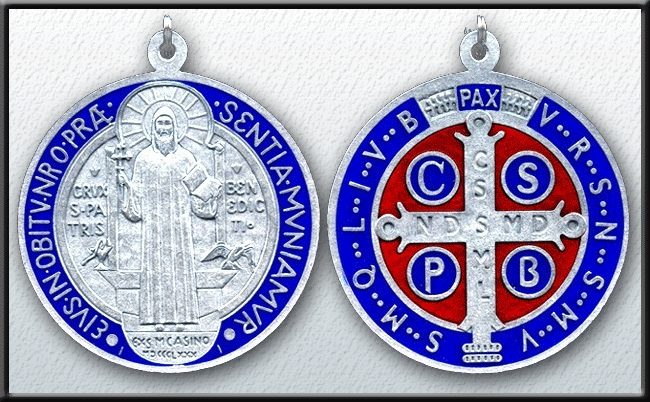It is definitely a what most Catholics familiar with sacramentals call a St. Benedict’s Cross. In reality it should be called a St. Benedict Crucifix.
The three holes in the cross were there to hold the corpus attached the cross. The corpus being the body of Jesus on the Cross.
The following image bears this out!
Sometimes the Medal of St. Benedict is also incorporated into a crucifix, as seen above.
I am almost certain that if your cross actually contains some liquid at the cross beam, I would not hesitate to say that your Crucifix was obtained from Lourdes, France and as such contain a little of the miraculous water from the Sanctuary of Our Lady of Lourdes. The Feast of Our Lady of Lourdes (February 11) is also known as the World Day of the Sick
Lourdes water flows from a spring at the same spot where it was discovered by Bernadette. The original spring can be seen within the Grotto, lit from below and protected by a glass screen. Pilgrims drink Lourdes water due to its reputed healing power. The water is accessed from individual taps located between the grotto and the baths, The water from Lourdes was thoroughly analysed by independent chemists in 1858 and 1859, and does not appear to have a latent power to cure and has no special scientific or medicinal properties. Despite this, the water is itself a strong symbol of devotion for Lourdes pilgrims, and many buy statues and rosary beads containing small vials of it, and take home large plastic containers of it.
The sacramental in your possession may also have a connection with St. Maurus. The two above mentioned incidents actually alludes to this.
The Blessing of Saint Maur is customarily bestowed on the sick with a relic of the true Cross, in hopes of assisting to restore their health. Since it is often impossible to have a relic of the True Cross, in 1959, the Sacred Congregation of Rites granted permission to use the medal of St. Benedict in place of the relic of the True Cross to confer the Blessing.
All in all, one thing is certain, from the letters you quote, the cross in question is a St. Benedict Crucifix.
OF THE LETTERS, WHICH ARE INSCRIBED ON THE MEDAL
Besides the two Images of the Cross and—St. Benedict, there are also inscribed on the Medal a certain number of Letters, each of which is the initial of a Latin word. These words compose one or two sentences, which explain the Medal and its object. They express the relation existing between the Holy Patriarch of the Monks of the West and the sacred sign of the Salvation of mankind, at the same time that they offer the faithful a formula, which they may make use of, for employing the virtue of the Holy Cross against the evil spirits.
Those mysterious letters are arranged on that side of the medal on which is the Cross. Let us begin by noticing the four which are placed near the Cross, one at each of the outward corners: C S P B that is: Crux Sancti Patris Benedicti; in English: “The Cross of Holy Father Benedict.” These words explain the nature of the Medal.
On the perpendicular line of the Cross itself, are these letters: C S S M L they stand for these words: CRUX SANCTA SIT MIHI LUX; in English: “May the Holy Cross be my Light.”
On the horizontal line of the Cross are these letters: N. D. S. M. D. the words which they imply are: NON DRACO SIT MIHI DUX; in English: “Let not the Dragon be my guide.”
These two lines put together forum a pentametre verse, containing the Christian's protestation that he confides in the Holy Cross, and refuses to bear the yoke which the devil would limit upon him.
On the rim of the Medal there are inscribed several other Letters; and first the well-known Monogram of the holy name of Jesus, IH St. Faith and our own experience convince us of the all-powerfulness of this divine Name. Then below, beginning at the right hand, the following letters: V. R. S. N. S. M. V. S. M. Q. L. I. V. B. These initials stand for the two following verses. VADE RETRO, SATANA; NUNQUAM SUADE MIHI VANA. SUNT MALA QUAE LIBAS; IPSE VENENA BIBAS. in English: “Begone, Satan! And suggest not to me thy vain things; the Cup thou profferest me is evil; drink thou thy poison.”


